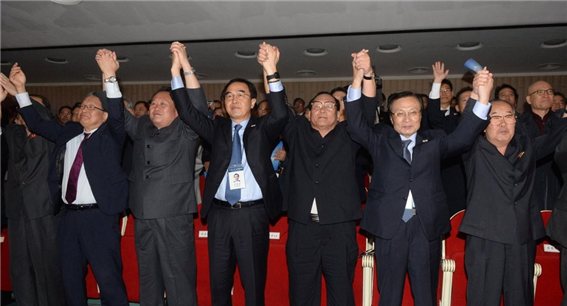Posted on : Oct.5,2018 18:06 KST
Modified on : Oct.5,2018 18:19 KST
 |
|
A ceremony commemorating the Oct. 4 Inter-Korean Summit Declaration of 2007 was held at the People‘s Palace of Culture in Pyongyang on Oct. 5. Representatives from North and South Korea held a joint celebration of the Oct. 4 Summit Declaration in Pyongyang, where they agreed to thoroughly implement the agreements of the Panmunjom Declaration and Pyongyang Joint Declaration.
|
The ceremony commemorating the Oct. 4 Inter-Korean Summit Declaration was held at the People's Palace of Culture in Pyongyang on Oct. 5. This was the first time since the declaration was made in 2007, 11 years ago, that the event was held jointly by South and North Korea.
Prior to the ceremony on Oct. 4, a South Korean delegation of 160 people representing the government, the National Assembly and NGOs – including Democratic Party head Lee Hae-chan and Unification Minister Cho Myoung-gyon – flew over the Yellow Sea to Pyongyang, where they were warmly greeted by their North Korean counterparts. At a time when the winds of peace are blowing on the Korean Peninsula, it’s meaningful that South and North Korea have held a ceremony to commemorate the Oct. 4 Declaration, which was a milestone in inter-Korean reconciliation and co-prosperity.
This is also of particular importance in the sense that it carries out agreements reached in the Pyongyang Joint Declaration announced during the September summit between South Korean President Moon Jae-in and North Korean leader Kim Jong-un.
The Oct. 4 Declaration, which resulted from the 2007 inter-Korean summit, detailed eight mid- and long-term tasks for building a peace regime on the Korean Peninsula and developing inter-Korean relations. If the joint declaration reached during the first inter-Korean summit on June 15, 2000, laid out a general outline for inter-Korean peace and prosperity, the Oct. 4 Declaration moved from the general to the specific.
The three inter-Korean summits held this year have basically provided concrete plans that flesh out the specific points made in the Oct. 4 Declaration. In particular, the points about inter-Korean cooperation toward ending military hostility between the two sides and support for summits with related countries aimed at formally ending the Korean War demonstrated the continuity between the Panmunjom Declaration in April and the Pyongyang Declaration in September.
But the conservative government that took power in 2008 didn’t make any sincere effort to implement the Oct. 4 Declaration, leading to the retrogression of inter-Korean relations. How sad it is to consider that, if South and North Korea had seriously tried to preserve the spirit of that agreement, the North Korean nuclear issue would not have gotten as bad as it is today and inter-Korean relations would have been able to develop at a much faster pace.
The long and difficult journey we have taken makes this joint commemorative ceremony even more significant. Since this large-scale inter-Korean joint event follows on the heels of the inter-Korean summit in Pyongyang, it should be able to help sustain the mood for inter-Korean cooperation. The inclusion of Unification Minister Cho Myoung-gyon, South Korea’s senior envoy to the inter-Korean high-level talks, on the delegation to the North means there is a high likelihood that talks will be held with the North to move forward with the action plans contained in the Pyongyang Declaration.
Since Lee Hae-chan is supposed to meet with Kim Yong-nam, the president of the Presidium of the North Korean Supreme People's Assembly, we hope that progress will be made on laying a foundation for exchange between South and North Korea’s legislatures. We also expect that the NGOs that are visiting North Korea will be able to take the steps necessary to diversify exchange.
Please direct comments or questions to [english@hani.co.kr]









